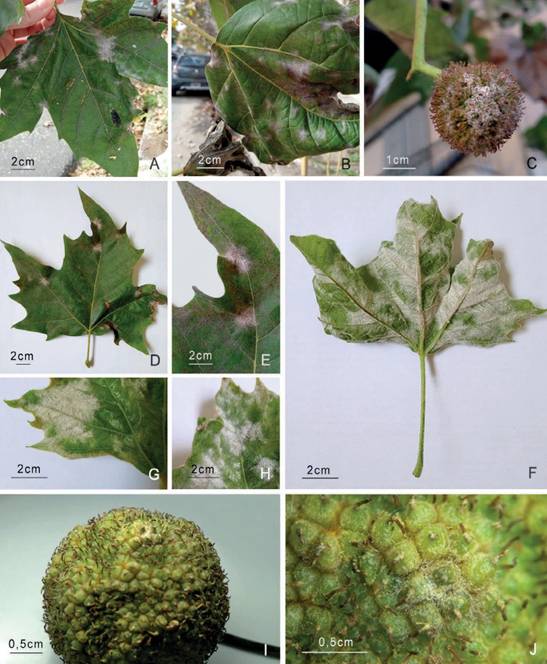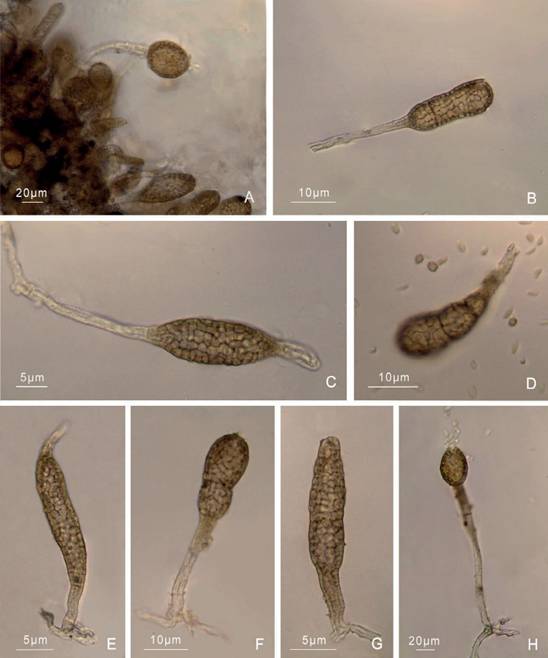INTRODUCTION
Platanus × acerifolia (Aiton) Willd., known locally as “plátano”, is an ornamental tree in urban areas, frequently planted in parks and along traffic routes in Argentina. During 2023, the presence of a disease affecting the foliage and fruits of P. × acerifolia (= P. × hispanica Münchh.) was observed in recreational places, streets, and other urban and rural areas in Tucumán (Argentina).
In the affected leaves, the presence of whitish-gray spots of powdery dusty ap- pearance was perceived. Based on the morphology of the asexual stages, as well as on the identity of the host plant species (Braun & Cook, 2012; Kirschner, 2011; Pastirčácová & PastirčáK, 2006, 2008), the causal agent of this powdery mildew infec- tion was identified as Erysiphe platani (Howe) U. Braun & S. Takam. It is a powdery mildew species native to North America, where is known to occur on Platanus spp., and has been introduced in South America, South Africa, Australia, New Zealand, Asia, and several European countries as well (Heluta et al., 2013). This is the first record of E. platani in Argentina Northwest (“Noroeste Argentino”; hereafter NOA). So far, it has only been reported from Mendoza (Klingner, 1982) and Buenos Aires (Braun et al., 2000).
However, another fungus associated with the mycelium of E. platani, causing dark gray colors and a dirty appearance, particularly towards the edge of the lesions, was detected. When these lesions were observed under a light microscope, abun- dant globose to pyriform fructifications were found affecting the hyphae, basal cells of conidiophores, and conidia of E. platani, causing alterations and deformation. The organism was identified as Ampelomyces quisqualis Ces. (Phaeosphaeriaceae), an ecologically and economically important hyperparasite that is widely distributed throughout the world (Kiss, 2008).
In this paper, we also report the presence of Ampelomyces quisqualis, a mycopara- site affecting powdery mildews in urban environments in Argentina. The symptoms caused by fungus on the infected plants and the microscopic characters of both parasites are described and illustrated.
MATERIALS AND METHODS
Specimens and morphology
Leaves and fruits of P. × acerifolia (adult individuals) were collected in Tucumán (NOA) in public spaces such as parks, pedestrian areas and so forth. Besides, other sample sites with infected plant communities from Buenos Aires, San Juan, and Santa Fe were included in this work.
Over 200 leaves and 40 fruits were examined under a magnifying glass for the presence of powdery mildew symptoms and studied under a light microscope. Fun- gal samples were taken from leaves and fruit and mounted in water for study with a light microscope. At least 30 values of conidiophores, pycnidia, and conidia were measured. Reference specimens were deposited at the fungal collection of Fundación Miguel Lillo (LIL).
RESULTS
Erysiphe platani (Howe) U. Braun and S. Takam., Schlechtendalia 4: 12, 2000. Bas.: Microsphaera platani Howe, Bull.
Torrey Bot. Club 5: 4, 1874.
Symptoms.- White powdery mildew colonies were apparent primarily on the upper leaves surface. Different frequencies and infection degrees by E. platani, depending on the leaf age, were noted. The infection was always more severe on younger leaves than on older ones. Stunting and distortion of young and terminal leaves of growing shoots were also observed. Infected trees did not exhibit symptoms of defoliation. Older, fully developed leaves exhibited few symptoms of the powdery mildew (Fig. 1). Immature fruits of P. × acerifolia also showed colonies of E. platani (Fig. 1 C,
I, J), together with A. quisqualis parasitizing them. In youngest fruits, the infection
was more intense and they showed more deformations.
Microscopic Characteristics (Fig. 2).- Mycelium was amphigenous, forming thin to dense colonies. Hyphae were branched, hyaline, smooth, with lobed hyphal ap- pressoria. Conidiophores were erect, 1-3 septate, with straight to flexuous foot cells, and conidia formed singly. The length of the conidiophores, often strongly influ- enced by external conditions is usually variable. When colonies grew more densely the conidiophores were longer than when they grew more sparsely.
Primary conidia were characterized by having sub-rectangular apices, hyaline, refractive, and measured 31.25-40 (-42.5) × 12.5-15 µm. Secondary conidia were ellipsoid to doliiform, with slightly convex ends, hyaline, and measured 33.75-43.75 (-50) × (-17.5) 18.75-20 µm. Conidial germ tubes were produced at one of the ends of conidia. The ascomata of E. platani were no observed.

Fig. 1 Platanus × acerifolia parasited by Erysiphe platani. A, B, D-H) Symptomatic leaves. C, I, J) Infected fruits. Fig. 1 Platanus × acerifolia parasitado by Erysiphe platani. A, B, D-H) Hojas sintomáticas. C, I, J) Frutos infectados.
Mycoparasite (Fig. 3).- Erysiphe platani were naturally parasitized by A. quisqualis. The infection was seen on colonies of the powdery mildew developing both on leaves as on fruits of P. × acerifolia.
The detected hyperparasite was observed inside the powdery mildew hyphae causing alterations and deformation. Pycnidia were dark brown to light brown col- ored, showed diverse morphology (globose, piriform, claviform, elongated or fusi27.5 µm, the elongated to fusiform (-60) 65-100 × 22.5-27.5 (-31.25) µm and the claviform ones, 100-150 × 18.75-25 µm. The pycnidia produced abundant ellipsoid to oblong hyaline conidia 6.25 (-7.50) × 2.50 (-3.75) µm.

Fig. 2 Erysiphe platani. A, B) Conidiophores with primary conidia and secondary conidia free. C) Conidiophore with primary and secondary conidia. D) Conidiophores with terminal conidia. E, F) Secondary conidia. G-J) Conidia with germ tubes. Fig. 2 Erysiphe platani. A, B) Conidióforos con conidio primario y conidios secundarios libres. C) Cinidióforo con conidio primario y secundario. D) Conidióforos con conidios terminales. E, F) Conidios secundarios. G-J) Conidios con tubo de germinación.
form) with variable size, according to each shape. When spherical they measured
37.5-43.75 (-50) × 22.5-35 (-37.5) µm, when piriform 60-90 (-125) × (-18.75) 20-

Fig. 3 Pycnidia of Ampelomyces quisqualis. A) General view of numerous pycnidia hyperparasiting E. platani. B, D, F) Piriform pycnidia. C, E, G) Conidiomata claviform, elongated or fusiform. H) Pycnidium globose liberating conidia. Fig. 3Pycnidios de Ampelomyces quisqualis. A) Vista general de numerosos picnidios hiperpara- sitando E. platani. B, D, F) Picnidio piriforme. C, E, G) Conidiomas claviforme, elongado o fusiforme H) Picnidio globoso liberando conidios.
Selected Specimens examined (all on Platanus × acerifolia infected with Erysiphe platani).- ARGENTINA. Buenos Aires, CABA, Barrio Retiro (calle San Martín), 34°35’27’’S 58°22’19’’W, 18 m snm, 23-Vlll-2023, L. Castillo 1992 (LIL 160893). San
Juan, Dpto. Capital (calle Santa Fe), 31°32’19’’S 68°30’55’’W, 638 m snm, 23-Vll-
2023, Romero 1986 1990 (LIL 160883); (calle Santa Fe), 31°32’18’’S 68°30’56’’W,
633 m snm, 23- Vll-2023, Romero 1987 (LIL 160881); (calle Santa Fe), 31°32’18’’S 68°30’59’’W, 640 m snm, 23-Vll-2023, Romero 1988 (LIL 160882); (calle Santa Fe), 31°32’19’’S 68°31’05’’W, 645m snm, 23-Vll-2023, Romero 1989 (LIL 160892). Santa
Fe, Dpto. Capital (calle Chacabuco 1773), 31°38’04”S 60°41’35”W, 31 m, 10-Vl-2023,
D. Alvarez (LIL 160.896); Capital (calle Chacabuco 1780), 31°38’05”S 60°41’36”W, 30 m, 10-Vl-2023, D. Alvarez (LIL 160895); Capital (calle Chacabuco 1880), 31°38’04”S 60°41’40”W, 33 m, 10-Vll-2023, D. Alvarez (LIL 160897); Tucumán, Dpto. San Mi- guel de Tucumán (calle Estados Unidos 70), 26°49’22’’S 65°11’37’’W, 446 m snm, 14-V-2023, L. Castillo 1978 (LIL 160884); 18-V-2023, L. Castillo 1979 (LIL 160885); (calle General Paz 1300), 26°50’01’’S 65°13’05’’W, 448 m snm, 16-V-2023, L. Cas-
tillo & G. Suárez 1980 (LIL 160886); (calle 24 de Septiembre 1250), 26°49’43’’S 65°12’59’’W, 453 m snm, 21-V-2023, G. Suárez 1981 (LIL 160887); (calle San Lorenzo 1700), 26°49’48’’S 65°13’23’’, 451 m snm, 22-V-2023, G. Suárez 1982 (LIL 160888); (avenida Mitre 300), 26°49’27’’S 65°13’03’’W, 456 m snm, 29-V-2023, G. Suárez 1983 (LIL 160889); (avenida Mitre 800), 26°48’59’’S 65°12’55’’W, 466 m snm, 29-V-2023,
G. Suárez 1984 (LIL 160890); Dpto. Trancas, San Pedro de Colalao (avenida de la entrada al pueblo), 26°13’58’’S 65°29’35’’W , 1069 m snm, 28-V-2023, G. Suárez 1985 (LIL 160891).
CONCLUSIONS
All Platanus × acerifolia trees screened for powdery mildew showed strong infections caused by E. platani. Younger leaves showed more symptoms of disease than older leaves. Although infections by this powdery mildew were detected previously on trees from other provinces (Buenos Aires and Mendoza), this study constitutes the first record of E. platani in Tucumán (NOA), Santa Fe and San Juan.
Erysiphe platani was heavily parasitized by A. quisqualis. This hyperparasite, wide- ly distributed throughout the world, is highly studied because of both its ecological importance and its consideration as a putative biocontrol agent. The interactions between powdery mildew fungi (biotrophic parasites of many plants) and pycnidial fungi belonging to the genus Ampelomyces are representative of mycoparasitic rela- tionships in nature (Kiss, 1998).
Our results show a parasitic interaction between A. quisqualis and the powdery mildew in natural environments of NOA. These observations were extended to infected trees in San Juan and Santa Fe from Argentina.














